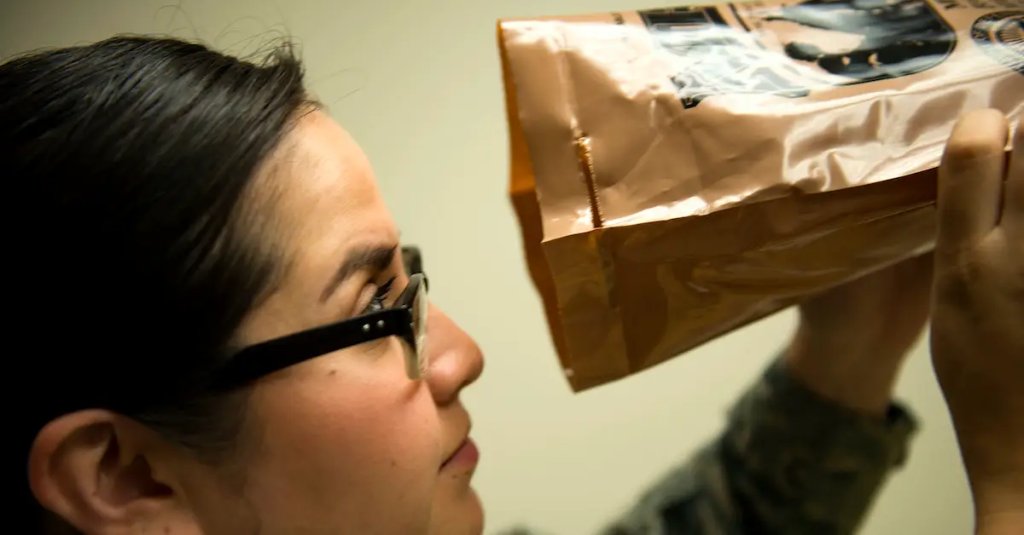

Since its official field debut in 1983, the MRE has come a long, long way. Today’s current iteration seems like veritable fine dining compared with previous versions, but they’re still widely considered “Meals Rejected by Everyone,” and “Meals Rarely Edible.” Take a look at how MREs have evolved over time and what the DoD is doing to make them more palatable.
1907: The Iron Ration becomes the first individual combat ration issued to military personnel and included three 3-ounce cakes made from beef bouillon powder and cooked wheat, three 1-ounce bars of chocolate, and salt and pepper.
1917: Reserve Rations are issued to soldiers during the end of WWI. These included 12 ounces of fresh bacon or one pound of canned meat, two 8-ounce cans of hardtack biscuits, 1.16 ounces of ground coffee, 2.4 ounces of sugar, and .16 ounces of salt—no pepper in sight.
1938’s C-Ration is closest to what many now think of as the MRE. It consisted of an individually canned, wet, pre-cooked meal. Service members had three choices: meat and beans, meat and vegetable stew, or meat and potato hash.

Just four years later, the 1942 K-Ration saw an increase in both calories and options. This MRE included meals for breakfast, lunch, and dinner, but the choices (canned ham and eggs, bacon and cheese for lunch, and a beef and pork loaf for dinner) weren’t that appetizing.
By 1958, the Meal, Combat, Individual (MCI) included canned wet rations averaging about 1,200 calories each. The majority of all service members disliked the MCI, but this remained the only field option available for almost twenty years.
Adopted as the official DoD combat ration in 1975, large scale production of Meals Ready to Eat began in 1978, and the first delivery went out just three years later. The 25th ID ate nothing but MREs for 34 days, and service members rated the food “acceptable,” but only about half of the meals were consumed. Translation: the food was super gross, and the soldiers only ate them out of necessity. Three years later, the same experiment was performed … with the same results.
So, starting in 1988, the DoD made some changes. Entrée size was changed from five ounces to eight ounces, and nine of the 12 entrée options were replaced. Candies were added to four choices, as was hot sauce, and for all 12 menus, cold beverage choices were made available.
But the MREs were still pretty gross.

Field testing and early feedback from Operation Desert Storm (ODS) brought another round of changes. This time, the DoD replaced old mil-spec spray-dried coffee with commercially freeze-dried coffee. Hot sauce was made available to all 12 menus, dehydrated fruits were swapped out for wet-pack fruit, and candy was made available to an additional four menus choices.
During ODS, service personnel ate MREs for as many as 60 days in a row, which resulted in another round of changes. Shelf-stable bread inside an MRE pouch was created, a chocolate bar able to withstand high heat was developed, and flameless ration heaters were developed as an easy method for service members to heat their entrees since the only thing grosser than eating MREs for two months is eating cold MREs for two months.
In 1994, more changes were field-tested. The DoD decided that commercial-like graphics should be added to increase consumption and acceptance. MRE bags became easier to open, and biodegradable spoons were added.
1996 saw MREs available for special diets to help increase calorie intake for service members in the field. Menu counts increased to 16 items and included ham slices and chili. One year later, there were 20 entrée items, including cheese tortellini and boneless pork chops with noodles.
Current menu offerings include southwest style beef and black beans, pepperoni pizza, creamy spinach fettuccine, and vegetable crumbles with pasta in taco style sauce. While none of those sound exceptionally appealing, they’re far better than beef bouillon cakes of 1907.
Ranked as the best MRE available, the chili mac menu comes with pound cake, crackers, a jalapeno cheese spread, and candy. The worst choices tie between the veggie burger (which includes a knockoff Gatorade powder, two slices of snack bread, and a chocolate banana muffin) and the Chicken a la King, which sounds yummy but is, in fact, just a gelatinous goo of shred of “chicken.”
MREs are useful for FTXs and good to have on hand in case of natural disasters. They’re convenient and shelf-stable, so they’re a good addition to emergency preparations. But don’t count on them tasting that great.
